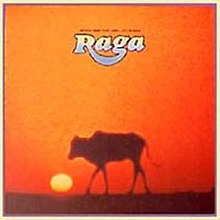Raga (film)
| Raga | |
|---|---|
 |
|
| Soundtrack album by Ravi Shankar | |
| Released | 7 December 1971 (US) |
| Recorded | April–July 1968; June–July 1971 |
| Genre | Hindustani classical |
| Length | 39:34 |
| Label | Apple |
| Producer | George Harrison |
Raga is a 1971 documentary film about the life and music of Indian sitarist Ravi Shankar, produced and directed by Howard Worth. It includes scenes featuring Western musicians Yehudi Menuhin and George Harrison, as well as footage of Shankar returning to Maihar in central India, where as a young man he trained under the mentorship of Allauddin Khan. The film also features a portion of Shankar and tabla player Alla Rakha's acclaimed performance at the 1967 Monterey Pop Festival.
The majority of the documentary was shot in the late 1960s, during a period when Shankar's growing popularity saw Indian classical music embraced by rock and pop musicians and their audiences. Financial problems then delayed production until Harrison provided assistance through the Beatles' company Apple Films. In addition to actively promoting Raga, Harrison produced the soundtrack album – a project that led directly to he and Shankar staging the Concert for Bangladesh in August 1971.
The film's working title was alternately East Meets West and Messenger Out of the East. In 2010, to coincide with celebrations for Shankar's 90th birthday, East Meets West Music released a fully remastered version on DVD, titled Raga: A Film Journey into the Soul of India. The expanded soundtrack album was also made available, via digital download.
New York film-maker Howard Worth began work on Raga, a documentary film on Indian classical musician Ravi Shankar, in 1967, during the height of what Shankar describes in My Music, My Life (1968), the first of his two autobiographies, as "the great sitar explosion". The latter term reflected the interest that had grown in the West for Indian music and its extended works, known as ragas, over 1966–67, following the Beatles and other rock bands' adoption of the multi-stringed sitar into their sound. Aided by his befriending George Harrison of the Beatles, this phenomenon resulted in Shankar achieving pop star status. Music critic Ken Hunt describes him as having become "the most famous Indian musician on the planet" in 1966. Shankar was uncomfortable with this development, since his training had instilled in him a sacred purpose for India's musical heritage – namely, Nada Brahma ("Sound is God"). The film documents Shankar's concern that while old traditions were dying in India, they were simultaneously being misappropriated by America's youth culture, particularly through many in the West choosing to associate Indian classical music with psychedelic drugs.
...
Wikipedia

